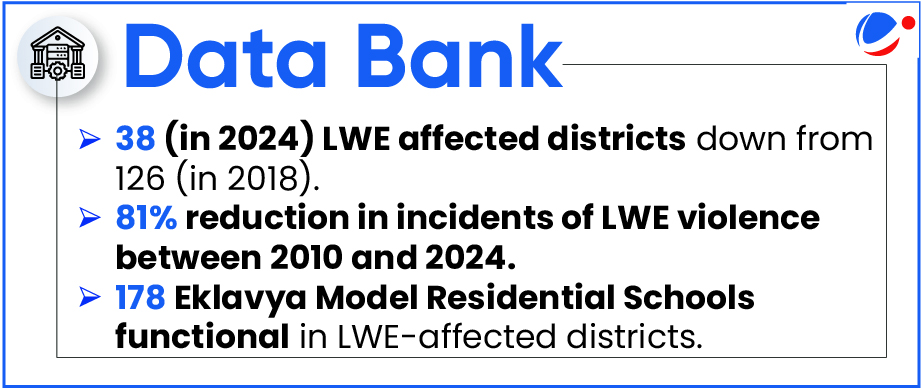Why in the news?
Recently, security forces conducted the largest ever anti-Naxal operation at Karreguttalu Hill on the Chhattisgarh-Telangana border.

More on the News
- The operation was conducted in line with the goal of achieving a Naxal-free India by March 31, 2026.
Naxalism in India
- Background: Naxalism or Left Wing Extremism (LWE) originated from the Naxalbari movement of 1967 in West Bengal.
- Ideology: Rooted in socio-economic inequalities and driven by Maoist principles, Naxalism has historically impacted some of the most remote, underdeveloped, and tribal-dominated regions of the country.
- Aim: The movement aims to undermine the Indian state through armed rebellion and parallel governance structures, particularly targeting security forces, public infrastructure, and democratic institutions.
- India's Red Corridor: It refers to Naxalism affected states like Chhattisgarh, Jharkhand, Odisha, Maharashtra, Kerala, West Bengal, Madhya Pradesh, and parts of Andhra Pradesh and Telangana.
- Modus Operandi: It includes armed violence, extortion, destruction of infrastructure, and recruitment of children and civilians.
Reasons for the decline of Naxalism

India's multi-pronged counter LWE strategy combining security, development, and community outreach has significantly reduced Naxal activity. Specific factors contributing to this decline include:
- Strengthened Security Architecture:
- SAMADHAN doctrine: It encompasses the entire strategy for security operations, ranging from short-term policy to long-term policy formulated at different levels.
- This includes providing Central Armed Police Forces (CAPFs), sanctioning India Reserve (IR) battalions, and supporting the modernization and upgradation of State Police forces for State Governments
- Security Related Expenditure Scheme: A Ministry of Home Affairs scheme aimed at capacity building of State Governments by reimbursing security-related costs, including training, operational needs, ex-gratia payments, and more.
- Special Infrastructure Scheme (SIS): Provides funds for strengthening State Intelligence Branches, Special Forces, District Police, and Fortified Police Stations.
- Intelligence and Operations: Real time multi-agency intelligence enabling precise operations.
- Financial Crackdown: Target funding sources through Prevention of Money Laundering Act enforcement and fund seizures.
- Development Interventions:
- Special Central Assistance (SCA) for most affected districts to fill critical infrastructure and service gaps.
- Financial Inclusion efforts including opening bank branches, ATMs, and post offices, and operationalizing Banking Correspondents.
- Skill Development and Education initiatives like establishing ITIs, Skill Development Centres, and Eklavya Model Residential Schools.
- Dharti Aaba Janjatiya Gram Utkarsh Abhiyan for providing personal amenities and benefitting the local population.
- Focus on strengthening Road connectivity, Mobile connectivity, and Financial connectivity (3-C).
- Community Engagement and Perception Management:
- Civic Action Programme (CAP) humanize security forces and build rapport between them and local people.
- Media Plan to counter Maoist propaganda, increase youth aspirations, and make them aware of development and opportunities.
- Assistance Schemes: Central Scheme for Assistance to Civilian Victims/Family of Victims of Terrorist/ Communal/LWE Violence (CSACV) provides financial assistance to affected civilians.
Persistent Challenges to Eliminating Naxalism
- Violent Ideology: The core challenge is the Maoist ideology which glorifies violence and aims to overthrow the democratic state structure.
- Front Organizations and External Alliances: These exploit legal systems, recruit cadres, raise funds, and align with other insurgent groups, sometimes with external support.
- Difficult Terrain: Remote, tribal regions like Karreguttalu Hill feature harsh geography and climate, complicating security operations.
- Trust Deficit: Cultural differences and perceptions reduce local trust in security and administration, limiting the impact of welfare measures.
Way Forward
- Addressing Trust Deficit: Enhance local participation in administration to bridge trust gaps.
- Ensure tribal-friendly land acquisition and rehabilitation policies to counter the spread of naxalism (Bandyopadhyay Committee).
- Policy measures that provide indirect benefits should be implemented with due care. For instance, Forest Rights Act, 2006, should be carefully implemented to empower local communities over Minor Forest Produce.
- Countering Ideological appeal: Uphold and promote the democratic principles enshrined in the Constitution as a countermeasure to violent Maoist ideology.
- Security and Capacity building: Prioritize modernization of local police forces and utilize small, intelligence-driven units, exemplified by the Greyhounds, to improve operational effectiveness.
- Centre-state coordination: Strengthen synchronized efforts with clearly defined roles to effectively combat radicalization and facilitate comprehensive development in affected regions.



